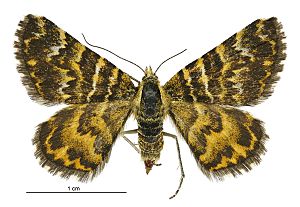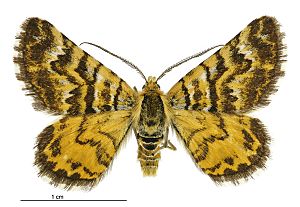Notoreas elegans facts for kids
Quick facts for kids Notoreas elegans |
|
|---|---|
 |
|
| Female | |
 |
|
| Male | |
| Scientific classification | |
| Genus: |
Notoreas
|
| Species: |
elegans
|
Notoreas elegans is a beautiful type of moth. It belongs to a group called Geometridae, often known as "loopers" or "inchworms." This moth is special because it lives only in New Zealand, meaning it's endemic there. You can find Notoreas elegans in many places across New Zealand, so it is not currently considered to be in danger.
Contents
About Its Name
Scientists officially named this moth Notoreas elegans in 2010. The people who described it were Brian Patrick and Robert J.B. Hoare. The word elegans means "elegant." They chose this name because the adult moth has very pretty colors and patterns on its wings.
What It Looks Like
When they are fully grown, N. elegans larvae (which are like caterpillars) have a brown head. Their body is bright green. They have a white band with hints of pink and yellow along their back. On the sides, they have some white shading and a pale white-pink stripe.
Adult N. elegans moths are quite striking. Their front wings have bright orange and white markings. Their back wings are orange with black patterns. This moth looks a lot like its close relatives, N. edwardsi and N. casanova.
Where It Lives
This moth is found only in New Zealand. You can spot N. elegans in valleys and mountain areas. It lives at different heights, from about 150 meters (490 feet) up to 1900 meters (6,200 feet). You can find it in places like the Mackenzie Basin, South Canterbury, Otago, and Fiordland.
Life Cycle and Behaviour
Most of the time, this moth has two groups of babies (called broods) each year. However, in some very cold places, it might only have one brood per season.
The female moth lays her tiny eggs inside the flower buds of its special host plants. When the larvae hatch from the eggs, they immediately start eating. They chew their way into the leaves or buds of the plant. This helps them hide from animals that might want to eat them. Once they grow bigger, they come out to feed on the fresh new parts of the plant.
When it's time to change, N. elegans larvae create a loose cocoon. They do this on the ground, usually right under their host plant. The moth stays inside its cocoon for about 43 days. After this time, it comes out as a fully grown adult moth.
N. elegans moths are active during the day. They fly low to the ground but can fly very fast. They constantly flutter their wings, which helps them take off quickly whenever they need to.
Host Plants
The larvae of N. elegans feed on specific plants. These plants are all native to New Zealand and belong to the Pimelea group. The host plants include Pimelea aridula, Pimelea oreophila, Pimelea pseudolyallii, Pimelea sericeovillosa, and Pimelea traversii.
Conservation Status
Because Notoreas elegans is found in many different places across New Zealand, it is not considered to be a species that needs special protection. Its wide distribution means it is not currently at risk of disappearing.

